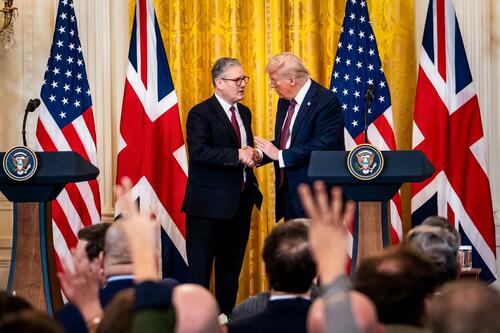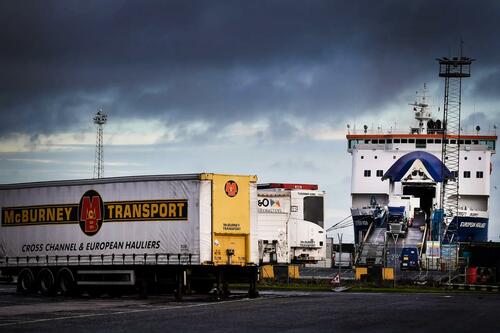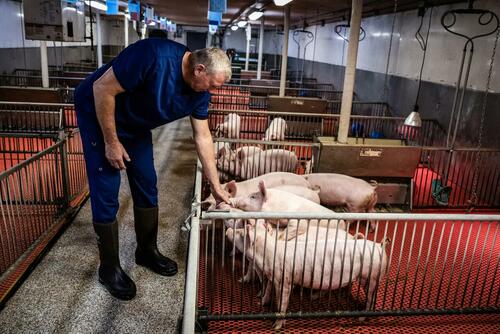
US–UK Trade Deal Highlights Gap In Agricultural Practices
Authored by Beige Luciano-Adams via The Epoch Times (emphasis ours),
The first trade deal to emerge from the Trump administration’s global tariff blitz is a narrow pact with one of the United States’ closest allies and a potential bright spot for U.S. agriculture.
 Illustration by The Epoch Times, Shutterstock
Illustration by The Epoch Times, ShutterstockThe White House said the Economic Prosperity Deal with the UK, signed June 16, includes “billions of dollars of increased market access for American exports, especially for beef, ethanol, and certain other American agricultural exports.”
The deal will provide tariff relief on British car exports, although deals on steel and aluminum have not yet been finalized.
The agreement will reduce or eliminate UK tariffs and nontariff barriers—which, according to U.S. President Donald Trump, have unfairly discriminated against U.S. goods—on some agricultural products, giving U.S. producers a $5 billion boost.
During a May 9 Oval Office news conference to announce the deal, a reporter asked Trump if he was calling on the UK to accept all U.S. beef and chicken, referencing a long-simmering standoff over food standards between the two countries regarding hormone-treated beef and chlorine-washed chicken from the United States, both banned in Europe and the UK.
Trump suggested that the UK could “take” what it wants from the United States’ agricultural options.
He also mentioned that Health Secretary Robert F. Kennedy Jr. is seeking to shift U.S. food standards—likely toward those of the UK and Europe, “with no chemical, no this, no that.”
And on May 22, Kennedy’s Make America Healthy Again commission delivered a report taking aim at processed food and chemical toxins as drivers of chronic disease and declining health among U.S. children.
There are questions about how far the principles underlying the report will be extrapolated across the administration. For example, the Environmental Protection Agency (EPA) has signaled that it does not plan to implement a “European mandate system that stifles growth” to reduce pesticide use.
But it was an encouraging step for those hoping that this administration will take a more precautionary approach to regulating food safety.
During Trump’s comments at the May 9 news conference, Agriculture Secretary Brooke Rollins interjected to add, “American beef is the safest, the best quality, and the crown jewel of American agriculture for the world.”
The exchange highlighted a significant difference between the two countries. The United States continues to use agricultural and animal management substances that are banned in the UK, including certain pesticides, genetically modified crops, growth hormones, and antibiotics.
Since the years leading up to Brexit—the UK’s 2020 departure from the European Union (EU)—when the country appeared ripe for prying from Europe’s regulatory apparatus, the U.S. government and agriculture industry have been aggressively lobbying to remove trade barriers for agricultural products.
 UK Prime Minister Keir Starmer and U.S. President Donald Trump shake hands after a joint press conference at the White House in Washington on Feb. 27, 2025. In May, the Trump administration reached a trade deal with the UK, granting limited U.S. market access in exchange for tariff relief on British car, steel, and aluminum exports. Madalina Vasiliu/The Epoch Times
UK Prime Minister Keir Starmer and U.S. President Donald Trump shake hands after a joint press conference at the White House in Washington on Feb. 27, 2025. In May, the Trump administration reached a trade deal with the UK, granting limited U.S. market access in exchange for tariff relief on British car, steel, and aluminum exports. Madalina Vasiliu/The Epoch TimesThis may prove more difficult now, as the UK on May 19 reached a deal to “realign” with the EU on several key issues, among them food safety and animal welfare standards.
Meanwhile, UK leaders have vowed that the new trade framework with the United States will not affect standards—affirming that a ban on hormone-treated beef and chlorinated chicken is a “red line” in negotiations.
Details are scant so far on the final terms of the deal and how it will ultimately shake out for the industry on both sides of the Atlantic.
And while some UK industry groups worry that an influx of U.S. products will drive down standards and prices, some U.S. observers see an opportunity to produce higher-quality U.S. exports.
A 1st Step
Trump has touted the deal, which establishes a reciprocal tariff-free quota of 13,000 metric tons of beef exports between the two countries each year—as a breakthrough that will increase access for “virtually all of the products produced by our great farmers.”
The White House has estimated that the deal will create a $5 billion opportunity for U.S producers, with more than $700 million in ethanol exports and $250 million “in other agricultural products, such as beef.”
U.S. agricultural producers involved in years-long lobbying efforts are hoping that a lot more will follow.
“For too long, the UK has limited America’s food and agricultural exports to the world’s sixth largest economy and now President Trump’s deal promises to level the playing field,” the International Dairy Foods Association said in a statement.
The U.S. Meat Export Federation thanked the Trump administration in a statement for prioritizing red meat in negotiations, and pushed for the inclusion of pork and the removal of remaining nontariff barriers.
As U.S. beef has not had any duty-free access to the UK since 2020, when the UK left the EU, the quota of 13,000 metric tons is important, Joe Schuele, senior vice president of communications for the federation, told The Epoch Times in an email.
But for U.S. producers to capitalize on the quota, barriers in existing export programs will have to be addressed, Schuele said, noting that the UK still adheres to all import requirements imposed by the EU for beef and pork.
 Vehicles carrying chilled meats and other items from the UK mainland disembark at Larne port in Larne, Northern Ireland, on Dec. 31, 2021. The recent U.S.–UK trade deal highlighted long-standing differences in food standards, including U.S. hormone-treated beef and chlorine-washed chicken, both banned in the UK and Europe. Charles McQuillan/Getty Images
Vehicles carrying chilled meats and other items from the UK mainland disembark at Larne port in Larne, Northern Ireland, on Dec. 31, 2021. The recent U.S.–UK trade deal highlighted long-standing differences in food standards, including U.S. hormone-treated beef and chlorine-washed chicken, both banned in the UK and Europe. Charles McQuillan/Getty Images“There are so many layers of bureaucracy that go above and beyond these two programs [beef and pork] that it’s hard for livestock producers to view them as viable paths into the European market,” he said.
While discussion of the UK’s nontariff barriers often focuses on the use of growth hormones—banned in the UK in 1989—Schuele pointed to other costly requirements hindering U.S. exporters, including “cumbersome plant approval procedures” as well as residue testing and antimicrobial wash restrictions imposed only by the UK and EU.
Protection not Bureaucracy
Where U.S. producers might see cumbersome bureaucracy, UK producers tend to see protection for food quality and prices.
Tom Haynes, head of the UK’s National Pig Association, said allowing U.S. pork imports would undercut UK prices and undo decades of work to improve standards.
“Allowing goods into the UK produced to standards that would not be legal for our producers, would represent a betrayal to British farmers,” Haynes said in a statement on May 9.
He noted that the United States tried hard to get pork into the first part of the deal, with “intense lobbying from the U.S. pig sector, and an 11th hour call from the U.S. President to the Prime Minister.”
Rollins said on May 13 that pork and poultry “are at the front of the line” in continued negotiations, along with seafood and rice.
UK poultry farmers were also happy to be left out.
“Excluding chicken from a UK–U.S. trade deal demonstrates a commitment to responsibility and transparency that defines British poultry meat production,” said Richard Griffiths, head of the British Poultry Council.
In a post on social media platform X, Liz Webster, founder of the nonprofit Save British Farming, said the deal would set a precedent, opening up a “flood of import [sic] food from countries that subsidise their farmers and allow lower standards.”
 Farmers drive tractors past the Palace of Westminster during a Save British Farming protest in London on March 25, 2024. The demonstration opposed UK food policy, substandard imports, and stricter labeling rules, with farmers calling for action to protect British agriculture. Henry Nicholls/AFP via Getty Images
Farmers drive tractors past the Palace of Westminster during a Save British Farming protest in London on March 25, 2024. The demonstration opposed UK food policy, substandard imports, and stricter labeling rules, with farmers calling for action to protect British agriculture. Henry Nicholls/AFP via Getty ImagesRisk Analysis
In its statement celebrating the deal, the White House pointed to UK tariffs, some higher than 125 percent, on U.S. meat, poultry, and dairy products. Added to the tariff burden, it said, are “non-science-based standards that adversely affect U.S. exports.”
The week after the deal was announced, Rollins met with UK officials and industry leaders to promote consumer choice and regulation based on science-based risk analysis, while stressing the safety of U.S. food and looking to dispel “misinformation” she said has circulated for decades in the UK.
Responding to questions about hormone-treated cattle at a news conference in London on May 13, Rollins said, “We have decades of research that show the beef produced in America, whether it’s hormone or hormone-free, is entirely safe.”
The secretary also clarified that over the past decade, the U.S. poultry industry has shifted away from using chlorine to wash poultry.
“Chlorine chicken—that’s a narrative in your country we have not done a good enough job pushing back on,“ she said. ”Only about 5 percent … of our chicken in America is actually treated that way.”
To disinfect chicken, U.S. chicken producers now mostly use peracetic acid, an organic compound—basically an industrial-strength equivalent of hydrogen peroxide and vinegar—that the European Food Safety Authority in 2014 deemed safe for use on meat.
UK regulators do not have an issue with the chlorine wash itself; both the UK and the EU permit chlorine washing. The UK approach is based on the position that proper hygiene and animal welfare make chlorine washing unnecessary—it is seen as a cover-up for low standards associated with large-scale factory farming.
While the UK’s “farm to fork” model includes tracing food hygiene at all stages of the production process, the United States has historically relied on end-stage testing to ensure safety.
A new Food and Drug Administration (FDA) rule will require traceability for a limited list of foods, including cheeses, eggs, and some produce and seafood items. However, that rule, mandated in 2010 and finalized in 2022, has yet to be enforced. The compliance date for the final rule has now been pushed back to July 2028.
Since the 2016 Brexit referendum opened a potential route for direct trade with the UK, U.S. officials and industry stakeholders have criticized what they consider Europe’s unfounded fears over food quality and safety, framing the U.S. approach as more modern and “science-based.”
In a 2019 op-ed, former U.S. Ambassador to the UK Robert Wood Johnson likened Europe to a “Museum of Agriculture,” contrasting its focus on history and tradition with the United States’ focus on science and innovation—a philosophical distinction, not a difference in quality, he said.
The same year, U.S. agricultural producers testifying during a public hearing to inform trade negotiations suggested that European restrictions on drugs such as ractopamine—a feed additive widely used in U.S. pork—lacked scientific basis and should be dropped.
 Dave Ayares, president and chief scentific officer of Revivicor, pets genetically altered piglets at the Revivicor research farm in Blacksburg, Va., on Nov. 20, 2024. Pork has been a key issue in U.S.–UK trade talks, with the head of the UK pig association warning that U.S. imports could undercut prices and reverse decades of progress on standards. Andrew Caballero-Reynolds/AFP via Getty Images
Dave Ayares, president and chief scentific officer of Revivicor, pets genetically altered piglets at the Revivicor research farm in Blacksburg, Va., on Nov. 20, 2024. Pork has been a key issue in U.S.–UK trade talks, with the head of the UK pig association warning that U.S. imports could undercut prices and reverse decades of progress on standards. Andrew Caballero-Reynolds/AFP via Getty ImagesResearch on human health effects of the drug is nearly nonexistent, but a lack of evidence proving its safety and concerning links to animal health issues have led more than 160 countries—including Russia and China, the biggest consumer of U.S. pork—to ban it.
The example demonstrates the difference in approach between the United States on the one hand and the EU and UK on the other. Absent scientific consensus about the health impacts of a drug or additive, European governments have typically prioritized human health and safety as a precaution when there are signs that a substance may pose a threat.
This “hazard-based” approach is based on the “precautionary principle” enshrined in European law.
Or, as the UK Food Standards Agency defines it, “In the interests of protecting public health from emerging food safety risks, the precautionary principle allows us to take action even if there isn’t time or data to undertake a full risk assessment.”
The United States, on the other hand, favors a “risk-based” approach focused on managing the risks of a potentially hazardous substance, often one that is already widely used.
“I think as soon as the UK can free itself from the precautionary principle, we’ll have a lot more opportunity to trade based on sensible regulations that are aimed at public health and safety, not at ill-founded fears,” Daniel Griswold, trade policy expert at George Mason University, said during a 2019 public hearing.
Pesticide Use
Pesticide use is another area in which the UK’s precautionary approach distinguishes it from the United States, but increasingly less so.
The UK plans to phase out chemical pesticides and reduce agricultural use of antimicrobials in the next several years. The United States has no such plan, but has offered some incentives in recent years to help farmers transition to organic.
The United States also allows higher maximum residue limits for pesticides than the UK for many foods—sometimes hundreds of times higher—and approves more pesticides than the UK and EU, according to an analysis by Pesticide Action Network.
In the UK, companies must prove no harmful effects on human health or the environment before active substances—the active components of pesticides—can be approved for use, and regulators can restrict use of a substance based on correlation with harmful effects, without requiring proof of causation.
Read the rest here…
Tyler Durden
Thu, 06/19/2025 – 05:30


















